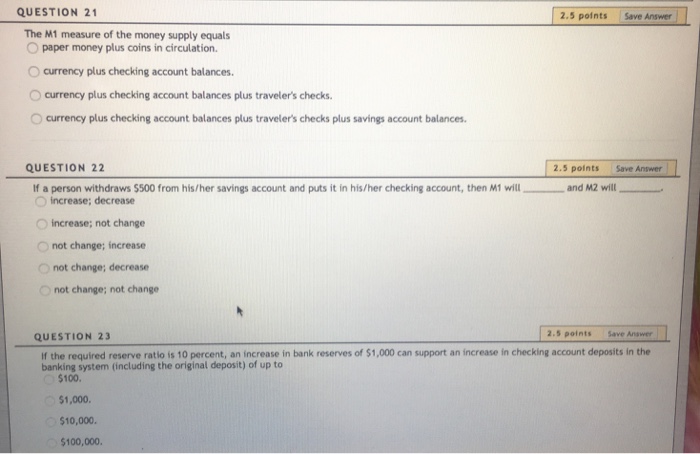5.M1 is:
A) currency + traveler's checks + checking deposits
B) currency +coins
C) currency + checking deposits
D) currency
6.If a bank's assets are $200 and the value of its weighted assets is $125, which is the
more restrictive capital requirement: the U.S. minimum equity ratio or the Basel Accord
requirement?
A) They are the same.
B) The United States ratio is the most restrictive.
C) The Basel Accord is the most restrictive.
D) There is not enough information provided to answer the question.
7. Which of the following includes consequences of the purchase and assumption method
of dealing with an insolvent bank?
A) The FDIC sells most of the assets and liabilities of the insolvent bank to another
bank.
B) Depositors lose their deposits and bank branches close.
C) The FDIC sells the insolvent bank's liabilities and earns a profit.
D) The bank keeps its original name.
8. Which of the following is a consequence of the payoff method of dealing with an
insolvent bank?
A) The FDIC sells the bank's assets for as much as it can get to pay off depositors.
B) The insolvent bank remains open under a new management.
C) The FDIC fund is not affected.
D) Small depositors lose 50 percent of their deposits.
9. Deposit insurance creates a moral hazard because it:
A) eliminates depositors' incentives to monitor banks.
B) reduces the cost of a bank failure for depositors.
C) encourages depositors to leave their funds in a weak bank.
D) All of the answers are correct.
10. The Basel Accord set international standards for:
A) interest rate volatility.
B) reserve ratios.
C) bank capital requirements.
D) loan risk.
11. U.S. capital requirements mandate a ________ minimum capitalâassets ratio.
A) 0 percent
B) 10 percent
C) 5 percent
D) 50 percent
12. Which of the following securities are banks not allowed to hold?
A) high-rated corporate bonds
B) stocks
C) municipal bonds
D) Treasury bonds
13. A bank run is an extreme form of:
A) credit risk.
B) interest rate risk.
C) low bank esteem.
D) liquidity risk.
14. One explanation for a bank run is:
A) adaptive expectations.
B) self-fulfilling expectations.
C) poor bank management.
D) that rising oil prices mean depositors require more cash.
5.M1 is:
A) currency + traveler's checks + checking deposits
B) currency +coins
C) currency + checking deposits
D) currency
6.If a bank's assets are $200 and the value of its weighted assets is $125, which is the
more restrictive capital requirement: the U.S. minimum equity ratio or the Basel Accord
requirement?
A) They are the same.
B) The United States ratio is the most restrictive.
C) The Basel Accord is the most restrictive.
D) There is not enough information provided to answer the question.
7. Which of the following includes consequences of the purchase and assumption method
of dealing with an insolvent bank?
A) The FDIC sells most of the assets and liabilities of the insolvent bank to another
bank.
B) Depositors lose their deposits and bank branches close.
C) The FDIC sells the insolvent bank's liabilities and earns a profit.
D) The bank keeps its original name.
8. Which of the following is a consequence of the payoff method of dealing with an
insolvent bank?
A) The FDIC sells the bank's assets for as much as it can get to pay off depositors.
B) The insolvent bank remains open under a new management.
C) The FDIC fund is not affected.
D) Small depositors lose 50 percent of their deposits.
9. Deposit insurance creates a moral hazard because it:
A) eliminates depositors' incentives to monitor banks.
B) reduces the cost of a bank failure for depositors.
C) encourages depositors to leave their funds in a weak bank.
D) All of the answers are correct.
10. The Basel Accord set international standards for:
A) interest rate volatility.
B) reserve ratios.
C) bank capital requirements.
D) loan risk.
11. U.S. capital requirements mandate a ________ minimum capitalâassets ratio.
A) 0 percent
B) 10 percent
C) 5 percent
D) 50 percent
12. Which of the following securities are banks not allowed to hold?
A) high-rated corporate bonds
B) stocks
C) municipal bonds
D) Treasury bonds
13. A bank run is an extreme form of:
A) credit risk.
B) interest rate risk.
C) low bank esteem.
D) liquidity risk.
14. One explanation for a bank run is:
A) adaptive expectations.
B) self-fulfilling expectations.
C) poor bank management.
D) that rising oil prices mean depositors require more cash.



